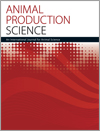Frank Dunshea (University of Melbourne and University of Leeds)

Animal Production Science
Volume 62 Number 12 2022
Special IssueRecent Advances in Animal Nutrition – Australia 2021
Frank Dunshea (University of Melbourne and University of Leeds)
ANv62n12_FOForeword: Recent Advances in Animal Nutrition – Australia 2021
The Australian Academy of Science recently released a Decadal Plan for the Science of Nutrition. This plan was focussed on human nutrition, but it is worth considering implications for production animal science and parallels with animal nutrition. While there are different contexts, there remains much that the animal production nutrition and human nutrition communities can learn from each other.
AN21151 Abstract | AN21151 Full Text | AN21151PDF (830 KB) Open Access Article
AN21219Recent Advances in Animal Nutrition – Australia: people and circumstances shaping this symposium
‘Recent Advances in Animal Nutrition – Australia’ has grown in stature over half a century to become Australia’s leading nutrition symposium. This history describes how the first ‘nutrition school’ was conceived at the University of New England, Armidale (UNE), in the early 1970s, and covers the 25 biennial meetings held at UNE; it pays homage to the many organisers, invited speakers and attendees who have focussed on finding innovative solutions to industry-relevant problems, thereby ensuring the symposium’s long-term success.
AN21219 Abstract | AN21219 Full Text | AN21219PDF (3.5 MB) Open Access Article
Following the banning or decline in the use of antibiotic growth promotors (AGPs), the use of probiotics in poultry production has increased rapidly. The present review describes recent advances in probiotic use in poultry, and focuses on the current understanding of gut health, how to assess it in chickens, and how to improve it via probiotic supplementation in poultry feeds. In particular, it explains the mechanisms how probiotics produce health benefits to the host, including improvements in bird performance.
AN20701 Abstract | AN20701 Full Text | AN20701PDF (7.3 MB) Open Access Article
Livestock probiotic and enzyme supplements are essential parts of diets globally, leading to important health and productivity benefits. Despite the wealth of new research discoveries and niche markets and needs, the development, manufacture and commercialisation of new probiotics and enzymes remains a major challenge for non-established companies and consortia. Here, these challenges are discussed along with the need to develop efficient laboratory-to-market platforms to deliver new and improved feed supplements.
AN21342 Abstract | AN21342 Full Text | AN21342PDF (897 KB) Open Access Article
A third of all food produced for human consumption globally is lost or wasted annually. Livestock animals, including insects, could function as efficient bioprocessors for converting unavoidable food waste into valuable animal protein. To be successful in establishing a sustainable food waste to livestock feed industry, it will be critical to ensure feed safety is appropriately regulated to prevent adverse animal health, welfare, biosecurity, food safety, economic, market access and food insecurity outcomes.
AN20667Recent advances in the use of phytochemicals to manage gastrointestinal oxidative stress in poultry and pigs
Reactive oxygen species are essential for normal biological function, but under conditions involving stress or ill health, conditions arise leading to ‘oxidative stress’. This is associated with poorer health and production outcomes and therefore is of significant concern. Increasingly, the properties of phytochemicals are being understood to protect against oxidative stress, improving the health and productivity of poultry and pigs.
AN21185Gut sensing of dietary amino acids, peptides and proteins, and feed-intake regulation in pigs
A balanced supply of dietary amino acids (AA) is essential to optimise growth in young animals. Deficiency or excess result in adaptive mechanisms involving the regulation of feed intake. This review has highlighted the chemosensory mechanisms behind the onset of appetite or satiety following dietary protein- or non-protein-bound AA in pigs. The mediation of gut-released hormones appears as a key process to control. The precise use of dietary AA has the potential to improve current pig nutrition practices.
Australia is among the top world suppliers of ruminant products, and hence a significant contributor to global CH4 emissions from livestock. Plant-based strategies may offer natural, sustainable and economical solutions for enteric CH4 mitigation from ruminants in Australia. This may include a range of low methanogenic forages or feed additives derived from plants.
AN21004 Abstract | AN21004 Full Text | AN21004PDF (587 KB) Open Access Article
AN21350Does the relationship between sow body composition change in lactation and re-breeding success still exist?
 , R. J. E. Hewitt, K. J. Plush
, R. J. E. Hewitt, K. J. Plush  , D. N. D Souza, J. R. Pluske, D. W. Miller and R. J. van Barneveld
, D. N. D Souza, J. R. Pluske, D. W. Miller and R. J. van Barneveld
Sow body composition reflects the amount of lean and fat tissue in the body and is measured and managed because, traditionally, when sows mobilise body tissues to support piglet growth during lactation, subsequent reproduction is adversely affected. The lean, efficient, modern sow is less likely to become catabolic and, so, does not suffer from poor re-breeding outcomes. This offers us the opportunity to feed the sow to better meet the needs of the piglet, without compromising subsequent reproductive performance.
AN21011Qualitative assessment of value in Australian pork across cultures
 , H. Ashman, R. J. van Barneveld, A. McNamara, N. Thomson, A. H. Hearn and F. R. Dunshea
, H. Ashman, R. J. van Barneveld, A. McNamara, N. Thomson, A. H. Hearn and F. R. Dunshea
Australian agricultural export has long been crucial to the country’s economy, the growing middle class of Asia and desire for premium Australian products across this region means that the profitability of these exports is expected to grow over the coming years. The present research aimed to bridge the gap in cultural understanding so as to maximise the potential of selling premium food products in the Asian market. The findings outline how two demographic groups (Australian and Chinese) see value in Australian pork.
AN20695Comparison of gastrointestinal transit times in stabled Thoroughbred horses fed freshly cut pasture and three conserved forage-based diets
 , Erica K. Gee, Gareth Fitch, Charlotte F. Bolwell, Sandra Kittelmann, Emma N. Bermingham
, Erica K. Gee, Gareth Fitch, Charlotte F. Bolwell, Sandra Kittelmann, Emma N. Bermingham  and David G. Thomas
and David G. Thomas
The type of forage offered to horses varies in physical form, moisture content and nutrient quality, and these variables may affect the intake, passage rate and digestibility of the forage consumed. There were significant differences among diets for dry-matter intake, eating behaviour and feed passage rate. Longer mean retention time was associated with a greater fibre content in the diet and a restricted feed supply, thus supporting the hypothesis that horses alter mean retention time on the basis of a nutrient absorption optimisation model.
AN20695 Abstract | AN20695 Full Text | AN20695PDF (597 KB) | AN20695Supplementary Material (972 KB) Open Access Article



